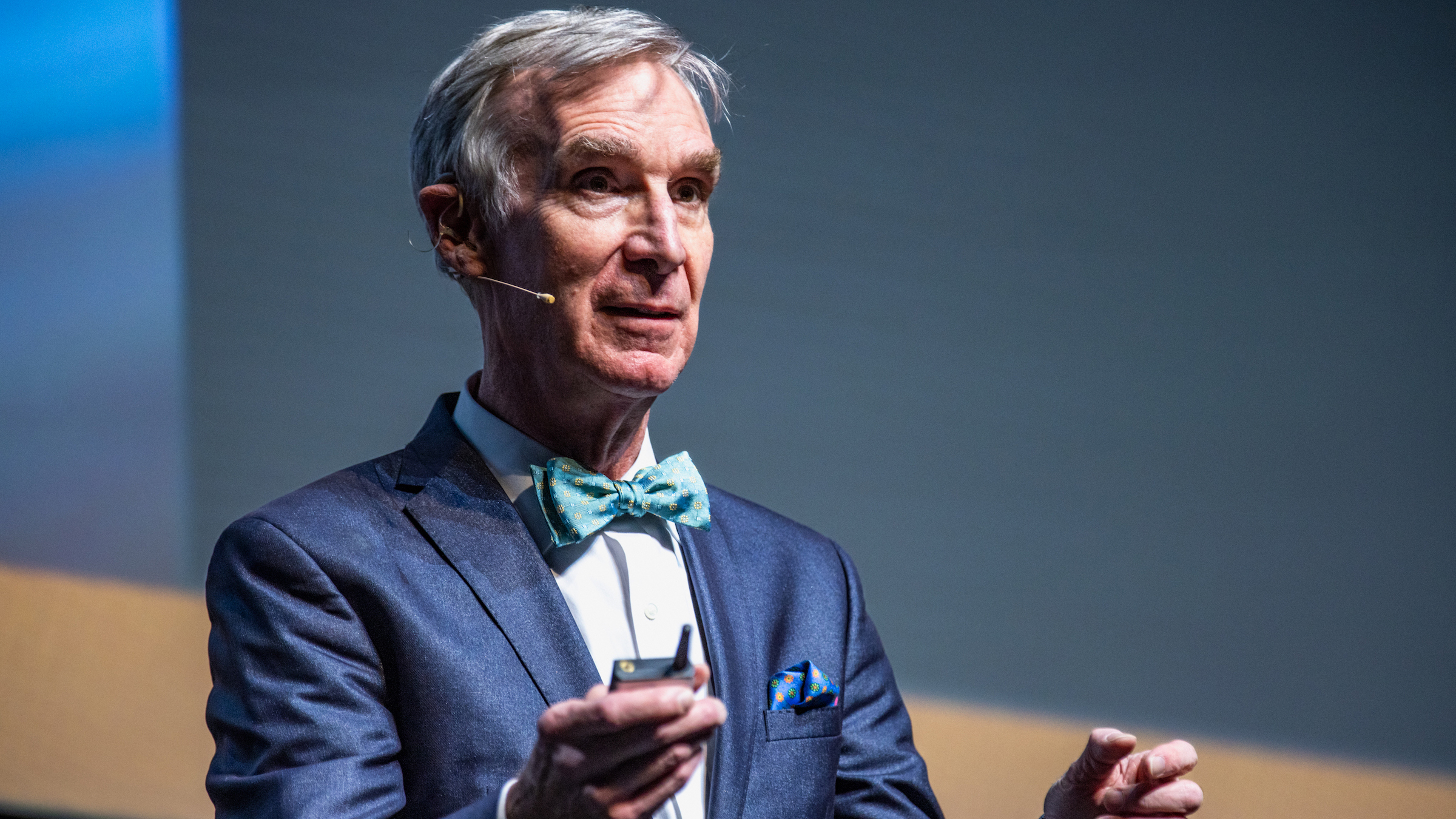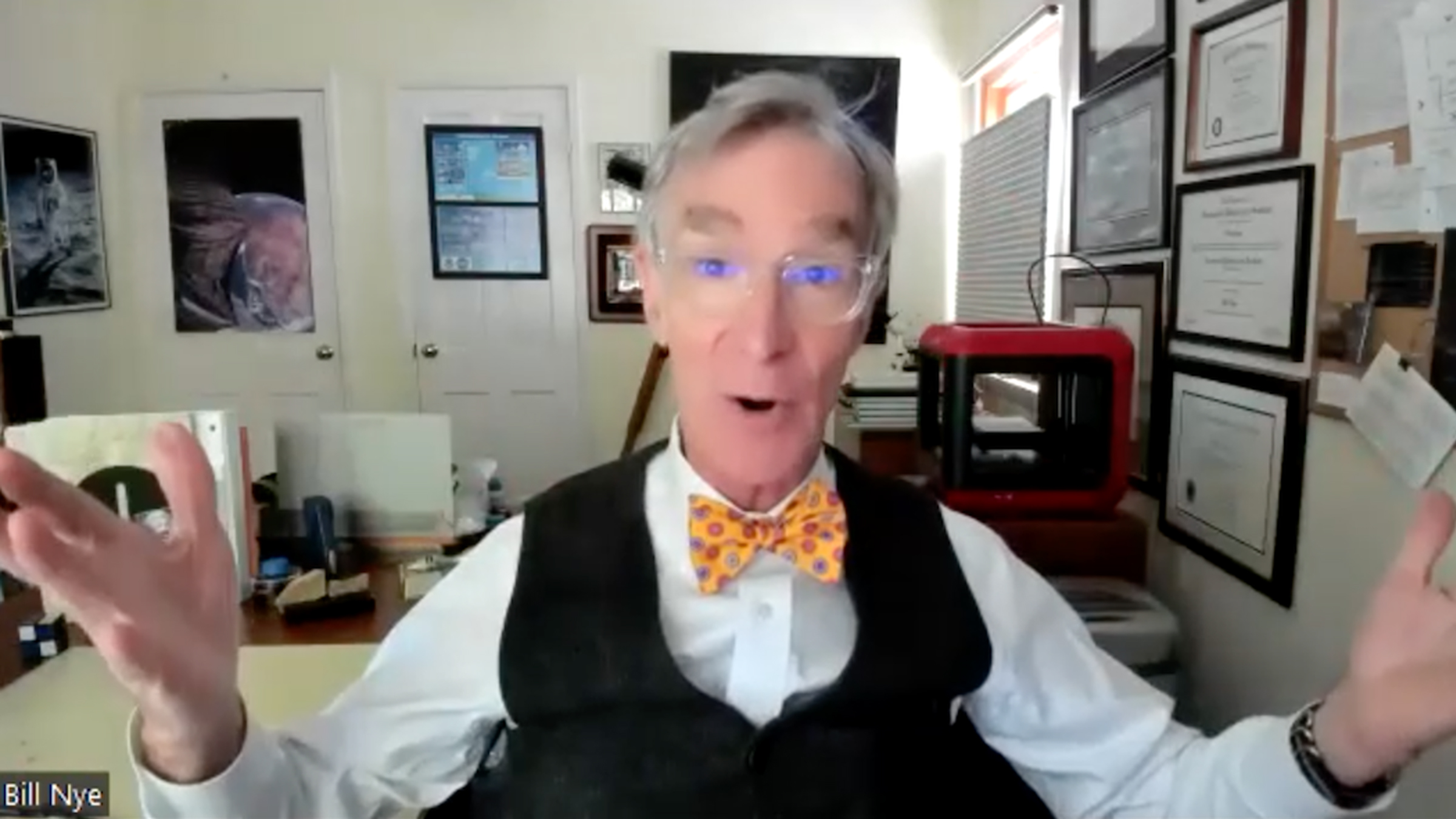Fusion power key to Earth's survival, says Bill Nye in exclusive interview
Bill Nye the Science Guy talks about what he would get our planet for Earth Day and "evidence-based optimism" in light of his latest show, "The End is Nye."

Editor's note: The following contains spoilers for "The End is Nye" series on Peacock TV.
What would Bill Nye the Science Guy get our home planet for Earth Day?
The ultimate gift: fusion energy.
"We need electricity," Nye told Live Science in an exclusive interview on Thursday (April 20). "We need not only what we can get right now with existing technologies — with wind, and solar and geothermal energy — but we need that so-called baseload. We need electricity when the sun's not shining and the wind's not blowing." And although powerful, nuclear energy carries the risk of a meltdown and creates nuclear waste, he added.
Fusion is an achievement any scientist would go starry-eyed over. With nuclear fusion — a process that smashes two light atoms together to create a heavier, new element, just as the sun does when it fuses hydrogen atoms together to make helium — humans would have clean, nearly limitless energy.
Related: What's the minimum number of people needed to survive an apocalypse?
Scientists have spent decades searching for this elusive source of near unlimited power, and are closer than ever to achieving fusion, but despite major advancements, useful, cost-effective nuclear fusion is still many years away. To achieve such a feat would be an invaluable present for Earth Day on Saturday (April 22). It would also make for a nice gesture from the Science Guy to the planet given that in Nye's latest TV series, "The End is Nye," Mother Nature basically kills him in every single episode.
Get the world’s most fascinating discoveries delivered straight to your inbox.
The series, released in December 2022, details how a multitude of planet-wrecking disasters, such as simultaneous record-breaking hurricanes; a swarm of earthquakes and tsunamis; harrowing dust storms and a string of space rocks slamming into Earth, could play out, should they come to pass.
"I get killed seven times in six shows," Nye said. "But then I come back."
Watch The End is Nye on NBC Peacock: $4.99/month for Premium or $9.99/month for Premium Plus (no ads)
Sign up to Peacock to watch Bill Nye as he explores all the world of disasters, both natural and man-made, and explain how we can survive the worst that the world can throw at us.
In every episode, with cameos from executive producer Seth MacFarlane, Nye investigates how humans could exacerbate these disasters through so-called "acts of cow," which refers to a cow that allegedly kicked over a lantern and started the Great Chicago Fire of 1871. (Despite popular use of the phrase, this story may not be true and may have racist overtones, as the woman who owned the cow was reportedly poor, Irish and an easy scapegoat to frame for the tragedy, Nye noted.) It would be an act of cow, for instance, for government agencies to fail to act if potentially hazardous asteroids were zooming toward Earth, or if officials didn't shut down electrical grids before a solar storm threatened to fry their electrical components to smithereens.
As he walks us through the science of each disaster in the show, Nye provides "evidence-based optimism" about how we could form scientifically informed plans to avoid such acts of cow and protect against the worst of these chilling scenarios.
"Well look, you have to be optimistic, or you're not gonna get anything done — and I'm talking about anything," Nye said. "If you think you're gonna lose the soccer game, you will lose." Except in this case, the result of the soccer game concerns the fate of all humanity.
But in addition to optimism, we also need a plan, and that's where science comes in, he said. "You've got to have a plan, not just hope and optimism," he said. "And that plan comes from science. From evaluating evidence."
It's no wonder Nye wants to gift Earth nuclear fusion, as this would help abate a lot of humanity's problems, including human-caused climate change, which is linked to a host of disasters, including increasingly severe hurricanes, heat waves and droughts that also grow more frequent by the year.
In an example of an evidence-based plan that could one day come to fruition, fusion could help raise the standard of living for people worldwide by providing energy that could power the internet, which in turn could deliver education, especially to families and women, he added. "Then, I believe we could invest in and have clean water for everybody on Earth," he said. "That's it: change the world."
Only humans are capable of formulating such forward-thinking plans that could protect and elevate our species. The dinosaurs, he said, were not so lucky when the asteroid collided with Earth 66 million years ago. It's not like they had the means to design and test a Double Asteroid Redirection Test (DART) mission like NASA did recently by using a spacecraft crash into to change the trajectory of an asteroid.
"There is no evidence that the ancient dinosaurs had a space program," Nye said. "If they did, it wasn't good enough, let's face it."

Laura is the archaeology and Life's Little Mysteries editor at Live Science. She also reports on general science, including paleontology. Her work has appeared in The New York Times, Scholastic, Popular Science and Spectrum, a site on autism research. She has won multiple awards from the Society of Professional Journalists and the Washington Newspaper Publishers Association for her reporting at a weekly newspaper near Seattle. Laura holds a bachelor's degree in English literature and psychology from Washington University in St. Louis and a master's degree in science writing from NYU.



